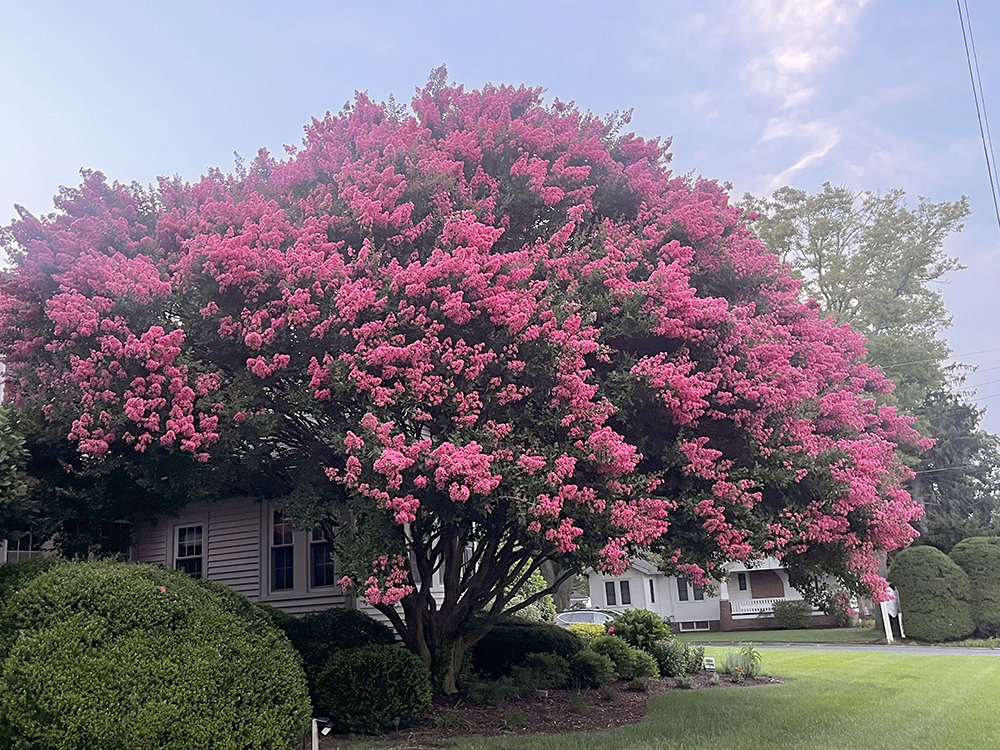Let It Grow
By Tammy Thornton
All over South Jersey, you may have noticed the late summer treat of beautifully blooming crepe myrtles. With clusters of pink, red, purple, and white, these long-lasting blooming trees offer a burst of late-season color, rewarding us for enduring the dog days of summer.
Since crepe myrtles are among the latest of the deciduous trees to leaf out, their late dormancy may have you questioning their health. But just in time, they will wake up and put on a show, providing us with interest throughout the year as well. After the clusters of crepe-paper-like flowers finish blooming late in the season, unique seed pods will form. Then as the weather becomes colder leading into fall, the leaves will turn shades of red, yellow, and orange. Once these deciduous trees lose their leaves, you can focus on the bark, which begins to peel as the trees mature, revealing variations of color under each layer of papery bark.
Crepe myrtles (also called crape myrtles) bloom best in full sun. They are popular in the southern states and are often referred to as “Lilacs of the South”. Due to warm winters, many gardeners in southern states find it difficult to grow lilacs, since lilacs need a period of cold dormancy to produce blooms. However, crepe myrtles flourish in the hot south. Living near the shore in South Jersey, we hit that sweet spot of hot summers and cold winters, enabling us to grow both flowering plants.

Crepe Myrtle, left to its own in full sun, will have a lovely form, full of blooms.
Our sandy South Jersey soil also provides the proper drainage for crepe myrtles, which are fairly drought-tolerant once established. They have the added benefit of being deer-resistant.
Though there are dwarf and mid-sized varieties, crepe myrtles can grow as tall as 30 feet or more. As a result of not realizing their potential height, gardeners may often find themselves in a difficult spot. Years after planting crepe myrtles, you may find that the tree is too big to move and too big to stay. This may lead to a pruning crime that’s become known as “crepe murder”. In order to bring their crepe myrtle back to size, well-meaning gardeners (or landscapers) will “prune” all of the large branches to shorten the tree, often using a chainsaw. As a result, each of these once healthy, strong branches will form unsightly knobs or knuckles, and at each cut, multiple tiny shoots will sprout. These tiny, whip-like shoots will be thin and weak, unable to hold the heavy flower clusters once they bloom. Avoid topping your crepe myrtles, and use a light hand when pruning. Prune suckers to the base of the plant and train lateral branches that block sidewalks or driveways. Cut out any dead branches or those that are crossing or rubbing against other branches. Depending on the variety, crepe myrtles usually have multiple trunks or leads, but you can thin some out by cutting to the base of the plant. Save yourself a lot of time and aggravation by doing your research and making sure the potential height of your crepe myrtle, as well as its canopy, will properly fit its space years from now. This fast-growing tree will provide you with years of beautiful flowers that pollinators will also appreciate.

As crepe myrtle trees mature, the bark will peel, revealing layers of tan, gray, and cinnamon bark.
We would love to hear from our readers. Send your comments, questions, or admissions of committing pruning crimes to shorelocalgardener@gmail.com.










